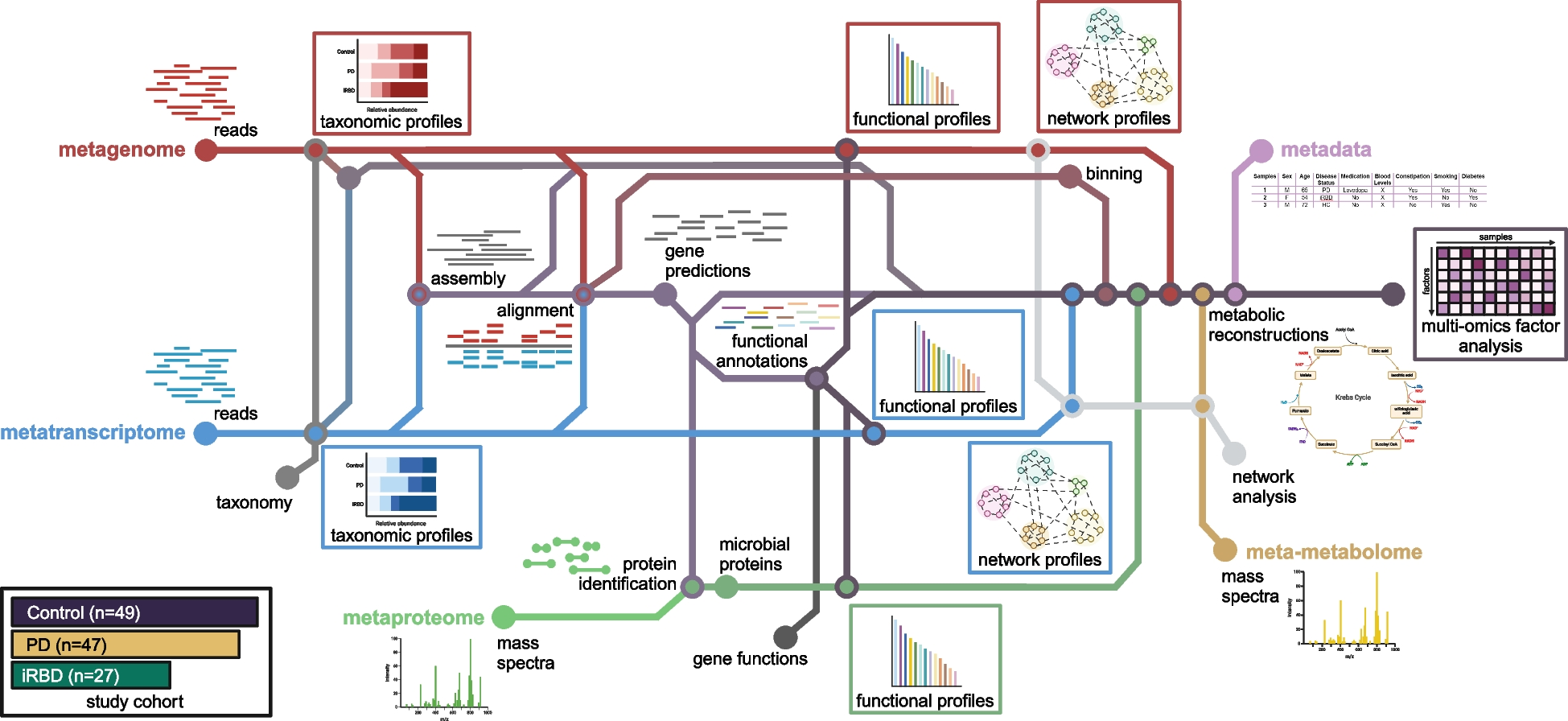Using multi-omics to delve into Parkinson's disease gut microbiome
Published in Microbiology and Neuroscience

Parkinson's Disease and the Gut Microbiome
Parkinson's disease (PD) is a neurodegenerative disorder affecting approximately 10 million people worldwide, with a steadily increasing incidence. Previous research has suggested a clear link between the gut microbiome and PD, particularly in patients with the "gut-first" subtype of the disease. In this context, we aimed to assess differences in the gut microbiome of PD patients compared to healthy controls (HC), and also to compare an early stage of PD—idiopathic REM sleep behavior disorder (iRBD)—with both PD and HC groups.
The design
In this study, we employed a multi-layered meta-omics approach, including metagenomics, meta-transcriptomics, meta-proteomics, and meta-metabolomics, to gain a deeper understanding of the gut microbiome in these individuals. We enrolled 46 healthy controls, 27 iRBD patients, and 49 PD patients, all with no recent history of antibiotic use or other known confounding factors.
How we did it
Given the vast number of potential features generated by a multi-omics approach, we chose to use meta-metabolomics as the primary driver of our statistical analysis. This decision was based on two factors: first, metabolomics data were not influenced by confounders, and second, metabolites represent one of the final outputs of microbiome activity. Through this approach, we identified several compounds—such as β-glutamate, bile acids, isovalerate & isobutyrate, and glycerol—that were differentially abundant in PD and iRBD patients compared to healthy controls. In addition, thanks to this approach we also simplified the statistical proceedings by reducing the amount of comparisons.
Chemotaxis, flagellar assembly and taxonomy.
Interestingly, β-glutamate remains poorly understood, with only one known enzyme capable of metabolizing it. To explore the potential functions associated with these metabolomic differences, we retrieved all KEGG orthologs (KOs) known to interact with the differentially present compounds and their related metabolites. This analysis revealed that many KOs were less expressed in PD patients, particularly those involved in chemotaxis and flagellar assembly (FA).
We observed a significant reduction in the expression of genes related to chemotaxis and flagellar assembly in the PD gut microbiome, with over 50% of these genes showing decreased expression in the PD group. Notably, these differences were not reflected in gene abundance or potential, suggesting that the microbial community retains the genetic capacity for these functions but no longer expresses them. We then investigated which microbial taxa were responsible for this decrease and found a complex picture: some bacterial clusters expressed FA genes predominantly in healthy controls, one cluster was specific to HC, and another expressed FA genes only in PD patients. This highlights the importance of identifying not just which functions are present, but which microbes are actively expressing them.
Function and Taxonomy: Both Matter
This study reinforces the importance of examining the functional activity of the gut microbiome, rather than focusing solely on its taxonomic composition. However, it also underscores that the identity of the microbes expressing specific functions is crucial and appears to be linked to disease status. We strongly believe that understanding microbiome functionality will be key to unraveling its role in disease and improving microbiome-targeted interventions. Reactivating or enhancing specific missing functions within a given microbiome may be the key to restoring balance and improving patient outcomes.
Related work
We published a little earlier a paper on the same cohort, but using a co-expression network on the ratio of meta-transcriptomic/metagenomics data. This approach led us to find a disrupted network in the gut microbiome of PD individuals and an apparent discontinuation of the cross-feeding between commensals. The paper can be found here: Very nice paper
Follow the Topic
-
Microbiome

This journal hopes to integrate researchers with common scientific objectives across a broad cross-section of sub-disciplines within microbial ecology. It covers studies of microbiomes colonizing humans, animals, plants or the environment, both built and natural or manipulated, as in agriculture.
Related Collections
With Collections, you can get published faster and increase your visibility.
Harnessing plant microbiomes to improve performance and mechanistic understanding
This is a Cross-Journal Collection with Microbiome, Environmental Microbiome, npj Science of Plants, and npj Biofilms and Microbiomes. Please click here to see the collection page for npj Science of Plants and npj Biofilms and Microbiomes.
Modern agriculture needs to sustainably increase crop productivity while preserving ecosystem health. As soil degradation, climate variability, and diminishing input efficiency continue to threaten agricultural outputs, there is a pressing need to enhance plant performance through ecologically-sound strategies. In this context, plant-associated microbiomes represent a powerful, yet underexploited, resource to improve plant vigor, nutrient acquisition, stress resilience, and overall productivity.
The plant microbiome—comprising bacteria, fungi, and other microorganisms inhabiting the rhizosphere, endosphere, and phyllosphere—plays a fundamental role in shaping plant physiology and development. Increasing evidence demonstrates that beneficial microbes mediate key processes such as nutrient solubilization and uptake, hormonal regulation, photosynthetic efficiency, and systemic resistance to (a)biotic stresses. However, to fully harness these capabilities, a mechanistic understanding of the molecular dialogues and functional traits underpinning plant-microbe interactions is essential.
Recent advances in multi-omics technologies, synthetic biology, and high-throughput functional screening have accelerated our ability to dissect these interactions at molecular, cellular, and system levels. Yet, significant challenges remain in translating these mechanistic insights into robust microbiome-based applications for agriculture. Core knowledge gaps include identifying microbial functions that are conserved across environments and hosts, understanding the signaling networks and metabolic exchanges between partners, and predicting microbiome assembly and stability under field conditions.
This Research Topic welcomes Original Research, Reviews, Perspectives, and Meta-analyses that delve into the functional and mechanistic basis of plant-microbiome interactions. We are particularly interested in contributions that integrate molecular microbiology, systems biology, plant physiology, and computational modeling to unravel the mechanisms by which microbial communities enhance plant performance and/or mechanisms employed by plant hosts to assemble beneficial microbiomes. Studies ranging from controlled experimental systems to applied field trials are encouraged, especially those aiming to bridge the gap between fundamental understanding and translational outcomes such as microbial consortia, engineered strains, or microbiome-informed management practices.
Ultimately, this collection aims to advance our ability to rationally design and apply microbiome-based strategies by deepening our mechanistic insight into how plants select beneficial microbiomes and in turn how microbes shape plant health and productivity.
This collection is open for submissions from all authors on the condition that the manuscript falls within both the scope of the collection and the journal it is submitted to.
All submissions in this collection undergo the relevant journal’s standard peer review process. Similarly, all manuscripts authored by a Guest Editor(s) will be handled by the Editor-in-Chief of the relevant journal. As an open access publication, participating journals levy an article processing fee (Microbiome, Environmental Microbiome). We recognize that many key stakeholders may not have access to such resources and are committed to supporting participation in this issue wherever resources are a barrier. For more information about what support may be available, please visit OA funding and support, or email OAfundingpolicy@springernature.com or the Editor-in-Chief of the journal where the article is being submitted.
Collection policies for Microbiome and Environmental Microbiome:
Please refer to this page. Please only submit to one journal, but note authors have the option to transfer to another participating journal following the editors’ recommendation.
Collection policies for npj Science of Plants and npj Biofilms and Microbiomes:
Please refer to npj's Collection policies page for full details.
Publishing Model: Open Access
Deadline: Jun 01, 2026
Microbiome and Reproductive Health
Microbiome is calling for submissions to our Collection on Microbiome and Reproductive Health.
Our understanding of the intricate relationship between the microbiome and reproductive health holds profound translational implications for fertility, pregnancy, and reproductive disorders. To truly advance this field, it is essential to move beyond descriptive and associative studies and focus on mechanistic research that uncovers the functional underpinnings of the host–microbiome interface. Such studies can reveal how microbial communities influence reproductive physiology, including hormonal regulation, immune responses, and overall reproductive health.
Recent advances have highlighted the role of specific bacterial populations in both male and female fertility, as well as their impact on pregnancy outcomes. For example, the vaginal microbiome has been linked to preterm birth, while emerging evidence suggests that gut microbiota may modulate reproductive hormone levels. These insights underscore the need for research that explores how and why these microbial influences occur.
Looking ahead, the potential for breakthroughs is immense. Mechanistic studies have the power to drive the development of microbiome-based therapies that address infertility, improve pregnancy outcomes, and reduce the risk of reproductive diseases. Incorporating microbiome analysis into reproductive health assessments could transform clinical practice and, by deepening our understanding of host–microbiome mechanisms, lay the groundwork for personalized medicine in gynecology and obstetrics.
We invite researchers to contribute to this Special Collection on Microbiome and Reproductive Health. Submissions should emphasize functional and mechanistic insights into the host–microbiome relationship. Topics of interest include, but are not limited to:
- Microbiome and infertility
- Vaginal microbiome and pregnancy outcomes
- Gut microbiota and reproductive hormones
- Microbial influences on menstrual health
- Live biotherapeutics and reproductive health interventions
- Microbiome alterations as drivers of reproductive disorders
- Environmental factors shaping the microbiome
- Intergenerational microbiome transmission
This Collection supports and amplifies research related to SDG 3, Good Health and Well-Being.
All submissions in this collection undergo the journal’s standard peer review process. As an open access publication, this journal levies an article processing fee (details here). We recognize that many key stakeholders may not have access to such resources and are committed to supporting participation in this issue wherever resources are a barrier. For more information about what support may be available, please visit OA funding and support, or email OAfundingpolicy@springernature.com or the Editor-in-Chief.
Publishing Model: Open Access
Deadline: Jun 16, 2026




Please sign in or register for FREE
If you are a registered user on Research Communities by Springer Nature, please sign in